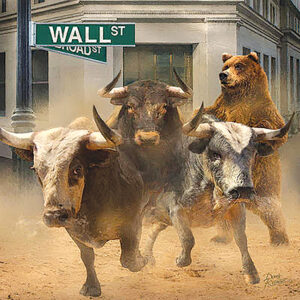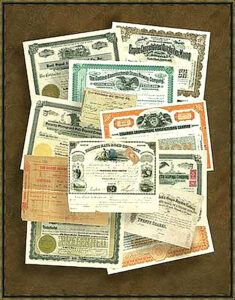 By Barry Krause
By Barry Krause In five short years the 100th anniversary of the devastating crash of the stock market in New York will be remembered. Thinking of this tragedy reminds me of the many nice items in stock market memorabilia that we can collect and study.
The stock market crash plunged America into perhaps the worst economic depression in our history. In October 1929, stock prices on the New York stock Exchange dropped so much that many investors saw their life savings wiped out.
An interesting collection of materials related to the New York stock Exchange itself could be assembled with patient searching for what we can find and afford. Old photos and art work of the stock Exchange buildings over the years, original letters and documents to or from stock Exchange employees, and newspaper or magazine accounts of stock Exchange activities come to mind.
A lot of the early memorabilia is already in museums, but it pays to know what to look for in case we happen to stumble upon vintage stock Exchange items that are, or aren’t, properly identified and priced for sale.
In 1792, a group of New York City stock traders got together under a buttonwood tree and agreed to direct business to each other. They formed a formal organization called the New York stock and Exchange Board in 1817, which changed its name to the New York stock Exchange in 1863 in the depths of the Civil War when a large amount of anti-Lincoln Southern sympathy ran rampant through the streets of New York City. It was forward thinking optimism that kept the stock Exchange going.
 There were market crashes and national economic depressions before, but the one begun in late October, 1929 was the worst in its effects on the whole country, in the opinion of some historians. I like any object related to the 1929 crash either directly such as dated ticker tape of stock price drops, diaries of business people or plain citizens who were ruined by the crash, obsolete stock certificates of companies that went bankrupt during the Great Depression of the 1930s, or indirectly such as books later written by eyewitnesses of Depression era daily life, local municipal “script” or metallic tokens issued by city governments to pay workers or citizens served when cash was short, “Depression glass” or other commercial products produced during those hard times, and political campaign memorabilia referring to the weakened stock markets. “Depression art” is a vast collectible field in itself, and amazing pieces can sometimes be found that show an artist’s concept of poverty-stricken residents trying to survive day-to-day, bankers leaping out of office building windows after their vaults went broke, “fun and games” enjoyed by broke people then, such as card games played for matchsticks or teenage dances with radio music and no refreshments visible. There are collectors in New York City and elsewhere who specialize in financial institution memorabilia, and we must compete with them when bidding for such items at advertised public auctions. That’s why seemingly cheap stockbroker signs and old stock Exchange identification badges bring such high prices these days.
There were market crashes and national economic depressions before, but the one begun in late October, 1929 was the worst in its effects on the whole country, in the opinion of some historians. I like any object related to the 1929 crash either directly such as dated ticker tape of stock price drops, diaries of business people or plain citizens who were ruined by the crash, obsolete stock certificates of companies that went bankrupt during the Great Depression of the 1930s, or indirectly such as books later written by eyewitnesses of Depression era daily life, local municipal “script” or metallic tokens issued by city governments to pay workers or citizens served when cash was short, “Depression glass” or other commercial products produced during those hard times, and political campaign memorabilia referring to the weakened stock markets. “Depression art” is a vast collectible field in itself, and amazing pieces can sometimes be found that show an artist’s concept of poverty-stricken residents trying to survive day-to-day, bankers leaping out of office building windows after their vaults went broke, “fun and games” enjoyed by broke people then, such as card games played for matchsticks or teenage dances with radio music and no refreshments visible. There are collectors in New York City and elsewhere who specialize in financial institution memorabilia, and we must compete with them when bidding for such items at advertised public auctions. That’s why seemingly cheap stockbroker signs and old stock Exchange identification badges bring such high prices these days. Early 20th century photos and picture postcards of the New York stock Exchange or of investor activities are often reasonably priced now, and I show a couple of examples here that I recently bought for a couple of dollars each.
Memorabilia from famous financiers who dabbled successfully in stocks can round out our collection. Bernard Baruch, the Wall Street Wizard, was once asked how he made so much money in the stock market. He replied that his investment philosophy was to buy when others are selling, and sell when others are buying. Unfortunately few people have the nerve to use this “contrarian” strategy consistently and stand alone by going against the trend of a changing market.
“Ticker” machines are wonderful collectibles if we can find original ones in nice condition. These once state-of-the-art devices are telegraphic instruments which automatically printed out stock prices and market reports on white “ticker tape.” The celebrated “ticker tape parades” in New York City involved business firms dropping used ticker tapes out of their office building windows to shower down on the parade participants in the streets below. Now they use confetti from a party supply store.
If you get a chance to visit New York, stop in to see the retail showroom of R.M. Smythe & Co. in lower Manhattan. Established in 1880, they specialize in buying, selling and appraising rare financial paper such as antique stock and bond certificates, U.S. and foreign paper money, Confederate currency and documents, and related books and autographs. They research obsolete stocks and bonds for a fee, but they will offer a quick opinion on whether or not a particular item is worth investigating.
While you’re there, you can visit the New York Stock Exchange nearby if they allow tourists to enter due to a low level security alert, but their admission rules can change at the last minute these days. Expect to be questioned by security guards or New York police if you take long videos of the exterior of the building, or “loiter” around the entrance in a suspicious manner.















Follow Us